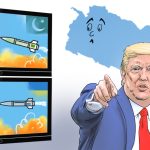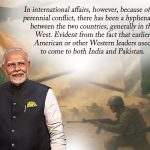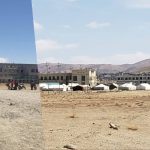Foreign policy and diplomatic relations of any modern democratic nation-state, including Nepal, should be grounded in objective realities. There should be no room for ideological biases, emotional trends, influence from inconsistent or sponsored notions, or psychological illusions.
Unfortunately, Nepal’s foreign policy has not adhered to this principle for a long time. Even on sensitive issues like foreign policy, we are influenced by ideological biases and emotions. While the state should base its policies and relations on objective grounds, the debates often diverge. Efforts to establish relationships are frequently misdirected.
We are gravitating towards the grandiloquent gossips and erudition of ‘world politics’ and ‘geopolitics’. However, we overlook the dimensions of ‘geoeconomics,’ ‘geoecology,’ and ‘geoculture’. The political documents of communist groups consistently feature a chapter on ‘The International Situation and Our Responsibilities,’ which merely seeks to reinforce the preconceived and classical approach of the Cold War era.
We deny, revile, and criticize the one with whom we have strong economic ties, high potential for national gain, and significant movement of our citizens. Conversely, we unnecessarily glorify relationships with those from whom we receive little or no benefit, portraying them as ideal. A heavy price has to be paid for this foolishness.
We need to focus on ‘national interest.’ In foreign relations, this translates to ‘citizen-centricity.’ In a modern democracy, the concepts of ‘nation’ and ‘citizen’ are indistinguishable and should be treated as such. While establishing relations with other countries, the benefits or drawbacks for its citizens should be considered.
However, while considering relationships with India, China, and America, we often overlook this reality. We fail to objectively compare the potential for our citizens’ movement, economic flow, employment, and immigration opportunities with each of these countries. We also neglect to assess the current or possible support we receive from them. There are no comparisons of such dimensions.
A country like Nepal, with its medium-sized area, population, and weak economy, should not take the burden of global geopolitical tensions.
There is a strong tendency here to portray India and the US negatively, labeling them as ‘expansionist’ and ‘imperialist,’ while depicting China as a more civilized, superior, ‘socialist’ country, which does not interfere in Nepal. This psychology contrasts sharply with our practical reality.
The view that sees India as ‘expansionist,’ America as ‘imperialist,’ and China as ‘socialist’ is an illusion created by communists in their annotation as per Nepal’s diplomatic relations and foreign policy. This can be termed as ‘comrades’ additional obsession’ with China.
Today, this mindset is attempting to appear in the form of an ‘unnecessary additional obsession’ with BRI. “Additional” in a sense, that it must meet a minimum criteria. The relationship with a vast neighboring country that is now the world’s second-largest economy cannot be underestimated or weakened under any circumstances. However, it must have a realistic approach. The relationship with China should be highly valued, but there should not be an ‘additional obsession.’
China’s economic progress today is not based on any socialist brotherhood or communist proletarian internationalism, nor is it possible or necessary. It has become a big ‘creditor state’ that lends money to the world for interest.
China had its reality in the past. It was different during the Mao era. Also, from Deng Xiaoping to Hu Jintao, China was different. Mao’s China was ideologically driven by communism. In contrast, Deng Xiaoping’s China was a more reserved and diplomatic country, focused on internal affairs and largely indifferent to the interests of others.
Xi Jinping’s China is neither socialist nor communist in the traditional sense. It is not like the Soviet Union during the Cold War. Today, China is neither opinionated nor calm, modest, and non-intrusive. Since 2014, China has become a creditor, merchant, and loan shark state with ambitions of world domination. It serves as a prime example of economic imperialism and state capitalism under the communist regime.
China’s economic progress today is not based on any socialist brotherhood or communist proletarian internationalism, nor is it possible or necessary. It has become a big ‘creditor state’ that lends money to the world for interest.
‘BRI’ is no longer a single, independent, and original grand project. Concepts like Global Security Initiative (GSI) and Global Civilization Initiative (GCI) are directly and indirectly connected with this. The essence of which is a ‘China-centered new world order’. BRI cannot be debated by hiding these facts.
Nepal’s act can not go forward on the belief that communist China is a ‘friend’ while democratic countries like India and America are ‘evil’. This perspective does not reflect objective realities. Strangely, Nepal’s communist forces have put the nation in such dilemmas.
Principally, whether they are truly communists or not, they thrive under the illusion of being communists in name and brand. They believe that they should defend China because China is a communist country. This involves portraying China positively while making others look bad. Based on this, efforts are made to align the Nepalese perspective with this kind of political schooling.
Such a tendency has also been seen in the context of BRI. Not only the communists but also the royalists, who claim to be a nationalist force, actually ‘so-called nationalists’ play a significant role in creating such notions and psychological confusion. For example, in the case of the MCC, both communist and monarchist forces were aligned.
Communists are naturally drawn to China due to ideological similarities. For royalists, the attraction stems from a shared affinity for authoritarian thinking. Since India and America are democratic countries, both royalists and communists view them as more threatening than China. This perception has shaped their political education and continues to influence their views today.
Sometimes, Nepali royalists discuss the strong emotional rapport and trust between King Mahendra and Mao. It is said that Mao did not support Nepalese communist leaders, remarking, “The king of your country is a communist, so why do you need a communist party?”
On the other hand, Mahendra had said that ‘communism does not come on vehicle in the context of Kodari highway.’ Although Nepal was formally a country having non aligned policy, during the Cold War period, the trend of the kings and royalists of Nepal was more towards communism than democracies.
Nepal’s relationship with India has had its ups and downs, and its relationship with America at that time was not particularly strong or significant. Royalists placed special importance on the roles of China and the Soviet Union.
Today, BRI has become the biggest issue in Nepal-China relations. The communists who demonstrated on the streets against the MCC received as a subsidy are making a speech in the parliament that Chinese loans with high interest rates are better.
Due to their confused desire towards China and affinity for communist ideology, the risk of falling into debt traps has increased. The country’s public debt is already over Rs. 240 billion, which is about 43% of its GDP. Some economists believe that the GDP has been artificially inflated to make the public debt ratio appear lower. This claim needs to be researched and reviewed separately to determine its validity.
It is estimated that about 20% of the annual budget will be used to pay off the debt’s principal and interest. If we take a large loan, such as the one for Pokhara International Airport (around 2% interest rate), Nepal’s annual budget will be consumed by current and financial expenses, leaving no funds for social security and capital expenditures.
It is estimated that about Rs. 280 billion will be needed to complete the proposed BRI project. If such a large debt is suddenly incurred, the public debt will reach about 90% of GDP. Pakistan and Sri Lanka have faced similar situations. Their economy, political stability, and international credibility were destroyed.
Reality of India-China-India Triangle
Let’s take a look at the statistics of Nepal’s people-to-people and economic relations with India, China, and America.
Based on area, China is the third largest country in the world after Russia and Canada. America is fourth and India is seventh. In terms of population, India is the first, China is the second and America is the third largest country. In terms of economy, America is the first, China is the second and India is the fifth largest country.
These comparisons suggest that, from Nepal’s perspective, India, China, and the United States should all be considered of similar importance. However, India is weaker than America and China in some respects because it is not a nation with veto power in the United Nations. Despite being the seventh-largest country in terms of area, it is less than half the size of China and America. Additionally, although India has the fifth largest economy in the world, its economy is significantly smaller than that of America and China.
India’s $3.93 trillion economy is much smaller compared to the $28.78 trillion economy of the US and China’s $18.53 trillion economy. Despite its vast land area and large economy, the United States has a relatively small population of about 340 million. In contrast, India has a population of about 1.4 billion, and China has around 1.3 billion people.
India and China are neighboring countries of Nepal, whereas the United States is not geographically connected to Nepal. The border between Nepal and India spans 1,850 kilometers, while the border between Nepal and China is 1,414 kilometers long. This difference in border length between Nepal and its two neighbors is notable but not extremely large.
The difference is that Nepal has an open border with India, both geographically and legally, allowing free movement between the two countries. In contrast, Nepal’s border with China is closed, both geographically and legally, with the Himalayas forming a formidable barrier. A visa is not mandatory to visit India but is mandatory after crossing peripheral regions of China. Nepalese can enter India without fees or restrictions, whereas traveling to China is limited for residents of border districts who must show their citizenship and are allowed only for a restricted distance.
Both India and China have security concerns with Nepal. On the one hand, China wants Nepal to avoid any actions that could support Tibetan separatism. On the other hand, India is concerned that competing countries like China and Pakistan might exploit the open border with Nepal to their advantage.
Nepal has 26 official border crossings with India compared to just two with China, at Kerung and Tatopani. Several other temporary checkpoints, including Olangchungola, Kimathanka, Korola, and Hilsa, which are crucial for Nepal, have not been regularized as official crossings.
Both India and China have security concerns with Nepal. On the one hand, China wants Nepal to avoid any actions that could support Tibetan separatism. On the other hand, India is concerned that competing countries like China and Pakistan might exploit the open border with Nepal to their advantage.
Approximately 2 to 3 million Nepalis work in various cities across India, which serve as key employment hubs for unskilled and semi-skilled workers from the Far West, Karnali, and Lumbini regions of Nepal. It is estimated that the Nepali population in the United States may reach between 300,000 and 500,000. Additionally, around 75,000 Bhutanese of Nepalese origin have migrated from Nepal to the United States which was a decades-long problem for Nepal.
Aside from Hong Kong, Macao, and Taiwan, the number of Nepalis in mainland China is less than 5,000. Despite this, Nepali leaders who frequently praise China rarely encourage Nepali workers to explore job opportunities in the country with the second-largest economy in the world.
From the point of view of trade, Nepal’s main partner country is India, followed by China. However, from the point of view of export trade, the second place is not China, but America. China ranks fifth in Nepal’s export trade. The top contributor of remittances to Nepal is Qatar, which provides 17% of the total remittances, followed by India with about 14%. The United States ranks ninth on the list, contributing 7.5% of Nepal’s total remittances. China does not appear in the top 20 countries providing remittances to Nepal.
Following the World Bank, the International Monetary Fund, and the Asian Development Bank, the United States is the next largest contributor to Nepal for development aid. While the effectiveness of this practice may vary, it is noteworthy that India provides subsidies to Nepal as part of its annual budget.
There are mountains and plateaus in the Tibetan region connected to Nepal. There are no large cities and a large population near Nepal. To the south are large population areas like West Bengal, Bihar, and Uttar Pradesh. The sea from Nepal to India is about 1000 km and the sea to China is 3700 km.
These facts indicate that while reality is in one direction, there is an attempt to shift perceptions in a different direction.
Conditions for China to be equal:
If China wants to be seen as an equal to India and the United States in its relationship with Nepal, it would need to meet the following conditions.
- At least 10 smooth, regular, formal, and modern checkpoints should be opened between Nepal and China.
- Nepali workers should be granted labor permits and employment opportunities in the Chinese labor market, with a flexible policy on immigration and gradually relaxed limits with open border policies.
- In addition to focusing on the export of Chinese goods to Nepal, China should offer Nepal special opportunities to export its goods to China, helping to reduce Nepal’s trade deficit.
Risks of BRI
The BRI agreement between Nepal and China was signed in 2017. However, after seven years, an implementation agreement has yet to be reached. KP Oli, who was Prime Minister when the agreement was signed, has returned to power. It remains to be seen what kind of implementation agreement he will pursue or if the issue will remain unresolved.
Based on the global experiences of various countries with BRI implementation, Nepal may face an increased risk of encountering the following five problems.
- Major projects built with expensive loans, but fail to generate returns, making it difficult to manage operating expenses.
- The estimated loans will be insufficient to complete the project, leading to its incompletion and the need to secure additional credit resources.
- The project will be leased out, avoiding the issues seen in Sri Lanka’s Habbanetta case by th lack of operating costs and repayment capacity.
- Public debt will increase unsustainably, making it difficult to manage capital interest, leading to higher financing needs and an economic crisis.
- Geopolitical tensions will escalate, increasing risks to peace and democracy.
In conclusion, it must be said that Nepal should avoid any ‘Additional obession’ with the BRI. The BRI should only be pursued if it involves implementing profitable projects with subsidies or at zero or low interest rates. Nepal should refrain from taking Chinese loans with high interest rates.This will only be the act to bankrupt the country.
Nepali Congress has already made it clear that loans can not be taken for BRI. Communist groups also need to clarify their stance on this issue. If the excessive obsession generated by communist ties influences the BRI, and an agreement is made for a high-interest loan, it would be a detrimental move.
Nepali version of the news story











